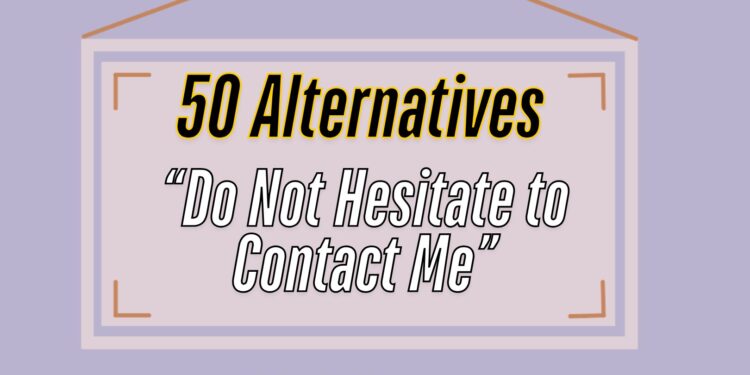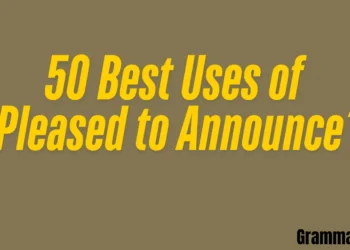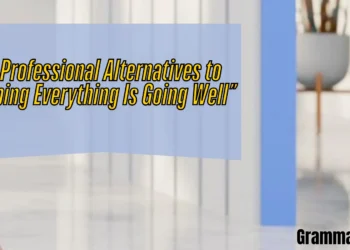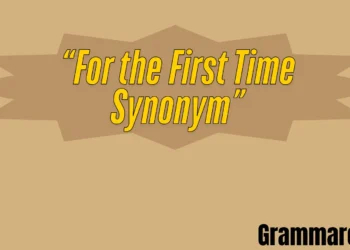Closing phrases help to establish the tone for next contacts, both at work and informally. “Do not hesitate to contact me”—a polite invitation indicating availability, openness, and support—is often used. This saying aims to create a warm atmosphere for more discussion, whether in emails, formal letters, or consumer service communications.
Although this phrase has good aims, it cannot always be suitable or successful in every circumstance. Depending on the situation, it can come out too formal, repetitive, or even passive. Knowing the tone, meaning, and applications of the phrase helps one decide when it offers value and when it might be preferable to go with another choice.
What Does “Do not Hesitate to Contact Me” Mean?
The phrase “Do not hesitate to contact me” gently motivates someone to get in touch with questions, worries, or requests. It calms the receiver by letting them know they are free to start more correspondence and that doing so would not be viewed as a hassle. Often, it helps the recipient and the sender to be open and trusting of one another.
When to Use “Do not Hesitate to Contact Me”
Professional emails, formal letters, client interactions, and customer service correspondence all benefit from this phrase. Show that you are friendly and prepared to support more by using it. At the conclusion of work application emails, project updates, business offers, or service-related replies, it works well to give a favorable impression.
Is It Professional/Polite to Say “Do not Hesitate to Contact Me”?
Yes, the term is commonly regarded as courteous and professional. It shows a readiness to assist or answer as well as adherence to traditional behavior. The context and tone of the message determine the degree of formality, nevertheless. In business or customer care environments, it is considered polite and respectful.
When to Avoid “Do not Hesitate to Contact Me”
In casual conversations or when your sincerity is already evident, avoid using this phrase. Particularly if overused or included next to more straightforward call-to-action language, it might also appear to be outmoded, robotic, or redundant. It could come off as too rigid or formal in informal conversations or in internal communication with colleagues.
Advantages or Disadvantages of “Do not Hesitate to Contact Me”
Advantages
- Expresses respect and professional behavior.
- Promotes open communication.
- Give the receiver encouragement.
- Suitable for a great number of formal settings.
- Fosters closeness and trust.
Disadvantages
- IT Might sound overly formal or rigid.
- It can seem impersonal or cliché.
- Frequent email endings are easily misused.
- Might not incite action as visibly as more powerful CTAs.
- Unsuited for fast-paced or informal communication environments.
50 Alternatives for “Do Not Hesitate to Contact Me
1. Please feel free to reach out to me.
Definition: A cordial invitation asking the recipient to start communication without doubt.
Explanation: This phrase is frequently used in professional and formal emails to convey willingness and readiness for more contact.
Example: Should you have any more questions regarding the proposal, don’t hesitate to get in touch with me.
Best Use: After giving first directions or information, follow-up emails or customer correspondence.
Worst Use: In casual text discussions or informal chats, it may sound excessively formal.
Tone: welcoming, supportive, and professional.
2. I’m happy to help—just get in touch.
Definition: A polite means of expressing desire to provide assistance and encourage follow-up.
Explanation: Perfect for both formal and informal contacts, this version employs a warm tone and personal willingness to support.
Example: I would be glad to help; please contact me if you have any problems.
Best Use: friendly emails, customer service replies, or personal commercial contacts.
Worst Use: Highly formal corporate communications where a more impartial tone is sought.
Tone: Approachable, friendly, semiformal.
3. Contact me at your earliest convenience.
Definition: A formal request for the receiver to contact as soon as they are able.
Explanation: While still exhibiting professionalism and courtesy, this variant suggests some hurry or significance.
Example: To complete the schedule, please call at your earliest convenience.
Best Use: Business strategy followups or time sensitive professional issues.
Worst Use: In everyday messages, it might sound inflexible or demanding.
Tone: Formal, respectful, somewhat urgent.
4. I’m available if you need further clarification.
Definition: A reassurance that the sender is willing to clarify more information or respond more generally.
Explanation: It denotes preparedness to help with continuous issues, particularly in detailed or educational meetings.
Example: I’m available if you want more clarification on the scope of the project.
Best Use: Technical talks, instructional emails, or training resources are best used here.
Worst Use: As a generic email closer when no response is anticipated.
Tone: Professional, precise, supportive.
5. Let me know if you need anything else.
Definition: A polite but informal offer for more resources or support.
Explanation: I It often follows delivering a solution and expresses a positive attitude as it wraps up a task or talk.
Example: Let me know if you need anything further about the client information.
Best Use: Internal team discussions, casual client encounters, or friendly business emails.
Worst Use: High-level executive or legal correspondence—it might lack appropriate formality.
Tone: Informal to semiformal, friendly, collaborative.
6. I’m here to assist you anytime.
Definition: Readiness to offer aid at any time is shown with a strong expression of availability.
Explanation: It shows continuing support, perfect for service-based sectors when availability counts or for customer care.
Example: I am here to help you anytime you need aid with your account.
Best Use: onboarding instructions, customer care emails, service provider contact.
Worst Use: Clarifying availability hours or borders is crucial.
Tone: Courteous, service-oriented, sympathetic.
7. Reach out if you require any support.
Definition: An invitation to contact the sender, should assistance or help be required is
Explanation: A more formal version that displays a supportive tone without being too personal.
Example: Reach out if you need any help throughout the next step.
Best Use: Project handoffs, staff directions, or vendor correspondence.
Worst Use: Informal or social chats—it may sound distant.
Tone: Formal, neutral, considerate.
8. Please contact me should you have any questions.
Definition: A Formal and elegant invitation for the recipient to contact with questions.
Explanation: Often employed in official documents or formal correspondence, this phrase gives a welcoming yet conditional tone.
Example: Contact me with any questions regarding the agreement.
Best Use: Legal, scholarly, or official corporate correspondence is the best use.
Worst Use: In casual or rapid exchanges, it may sound too formal.
Tone: Formal, polished, courteous.
9. I’m just an email/call away.
Definition: A friendly and consoling reminder of simple accessibility.
Explanation: This saying indicates that reaching out is straightforward and appreciated; it is conversational.
Example: Should you get into any difficulties, I am just an email away.
Best Use: Casual followups, team chats, amicable client interactions.
Worst Use: In conservative business environments, it may not have the desired level of professionalism.
Tone: Warm, reassuring; informal to semiformal tone.
10. You are welcome to contact me anytime.
Definition: At the receiver’s discretion, a courteous and inclusive offer for free communication.
Explanation: This edition emphasizes hospitality and accessibility, thereby suggesting no time pressure or restriction.
Example: You may contact me at any time with your issues.
Best Use: Customer service, onboarding, welcome emails, or service follow-up.
Worst Use: Time-sensitive issues needing a contact window specification.
Tone: Professional, courteous, welcoming.
11. Don’t think twice—just drop me a message.
Definition: An unstructured suggestion motivating someone to contact without excessive thought.
Explanation: This expression invites easy, conversational interaction in a welcoming tone, thus eliminating any reluctance.
Example: If you’re not sure about the plan, text me; don’t give a second thought.
Best Use: Friendly talks with coworkers or colleagues; text messages; or casual emails.
Worst Use: Formal or high-level corporate communication requiring professionalism.
Tone: laid-back, upbeat, warm
12. Feel free to ping me anytime.
Definition: Casual way of saying someone can reach you at any time.
Explanation: Usually found in communications between coworkers or teams, “ping” gives a tech-friendly, informal touch.
Example: Should the code not be working as it ought, please feel free to ping me at any moment.
Best Use: Among tech teams, internal conversations, Slack messages, startup settings, or internal chats.
Worst Use: Traditional business letters or with external customers in serious sectors.
Tone: Informal, digital native, friendly.
13. Your questions are always welcome.
Definition: A welcoming promise that questions are always welcome.
Explanation: This sentence welcomes inquiries and participation by putting the recipient at ease about asking questions.
Example: Particularly if anything in the report needs more clarity, your questions are always welcome.
Best Use: Emails for onboarding, mentoring, customer service, and education.
Worst Use: Time-sensitive or technical communications where only vital queries are allowed.
Tone: Welcoming, inclusive, helpful.
14. I’m here to support your needs.
Definition: A sincere promise to fulfill the demands or expectations of the recipient.
Explanation: Often employed in customer-centric or service-based situations, this phrase denotes a consistent presence.
Example: I’m here to meet your needs over the duration of the project.
Best Use: Follow-ups for client relationships, service roles, or account management.
Worst Use: When scheduling tight professional limits or restricted availability.
Tone: compassionate, professional, service-oriented.
15. You can contact me directly for assistance.
Definition: A courteous and adaptable invitation for next contact at the recipient’s discretion.
Explanation: The timing of the receiver is given priority, implying complete candour and no pressure.
Example: Reach out, whatever it works for you; together, we will work it through.
Best Use: Time-flexible contexts like creative cooperation, client onboarding, or mentorship.
Worst Use: Emergencies needing time sensitivity is imperative.
Tone: Respectful, semiformal, laid-back, and adaptable.
16. I’ll gladly provide further information.
Definition: An affable expression indicating that the sender would actually like communication.
Explanation: Open invitation to connect gains warmth and personal interest from this phrase.
Example: You are welcome to share your thoughts on how the event went.
Best Use: networking emails, cordial follow-ups, or relationship-building messages.
Worst Use: technical directions or merely commercial interactions.
Tone: Kind, polite, friendly, rather official.
17. Please connect with me for any updates.
Definition: A cozy and casual reminder that welcome is free for communication.
Explanation: It stresses access and advises starting contact requires little effort.
Example: Should you experience any glitches, I am just a message away.
Best Use: peer communications, ongoing projects, or casual support.
Worst Use: Legal papers or official requests demanding organized contact comprise the worst use.
Tone: Unofficial, friendly, encouraging.
18. If anything’s unclear, feel free to ask.
Definition: A kind invitation to elaborate more or keep the discussion going.
Explanation: Suggests eagerness for more communication or offering more assistance free of obligation.
Example: Always willing to discuss further if you wish to go further on the subject.
Best Use: casual Q&A, customer interactions, or follow-ups following a talk.
Worst Use: Final comments in corporate letters or reports.
Tone: Warm, casual, conversational tone
19. I’m committed to helping you.
Definition: A casual and informal approach, one asks someone to reach you.
Explanation: Often used in daily speech, it signals comfort and ease in reaching out.
Example: Should anything shift, just holler.
Best Use: Teamwork, daily peer communication, or friendly reminders.
Worst Use: is formal service offerings or high-stakes business contacts.
Tone: Very casual, calm, friendly.
20. Contact me to ensure everything goes smoothly.
Definition: An informal invitation to message with a casual offer to assist or support.
Explanation: Usually employed in team or group environments, this mixes support with informality.
Example: Get in touch if you require assistance setting up the presentation.
Best Use: Group projects, collaborative tools, or support inside a friendly team best use.
Worst Use: Contexts needing authoritative or organized communication.
Tone: Informal, supportive, friendly.
21. Let me know how I can best support you.
Definition: A light nudge promoting regular communication.
Explanation: Often employed to keep amiable or casual relationships, it discourages silence following a discussion.
Example: Reconnecting was wonderful; don’t be a stranger; reach out again soon!
Best Use: Networking follow-ups, friendly emails, or terminating social business conversations.
Worst Use: Official, legal, or academic documents need professionalism.
Tone: Personal, approachable, informal, playful.
22. I’m available for a follow-up discussion.
Definition: An uplifting statement to welcome continuous conversation or cooperation.
Explanation: This means mutual interest and the need for ongoing participation or dialogue.
Example: We have made remarkable progress; let’s keep the discussion ongoing next week.
Best Use: Collaborative planning, brainstorming sessions, or strategic alliances.
Worst Use: interactions that have been completed or closed decisions needing no further action.
Tone: Future-oriented, engaging, professional to semiformal.
23. Hit me up anytime.
Definition: A casual invitation for someone to call whenever they please.
Explanation: Common in text and informal digital communication, it indicates openness and friendliness sans formality.
Example: Let me know anytime if you wish to review the strategy once.
Best Use: social messages, friendly partnerships, and informal peer communication.
Worst Use: Professional or formal business emails—it may come across as too casual or unprofessional.
Tone: Extremely casual, easygoing, friendly.
24. Shoot me a message when you’re ready.
Definition: A laid-back approach of speaking allows the recipient to reach out on their own time.
Explanation: Common in informal digital contexts, this phrase provides adaptability while yet encouraging interaction.
Example: Contact me when you are prepared to review the design.
Best use: teamwork, creative projects, or peer collaborations.
Worst Use: is formal contexts where deadlines, standards, or structures are essential.
Tone: casual, adaptable, welcoming.
25. I’m always around to chat.
Definition: A cordial method of expressing one’s availability for discussion.
Explanation: Shows the speaker is approachable and ready to participate in impromptu or ongoing discussions.
Example: Should you ever want to run ideas past someone, I am available anytime to talk.
Best Use: Team settings, informal workplaces, or inventive collaborations.
Worst use: Formal corporate, legal, or academic correspondence.
Tone: friendly, relaxed, supportive.
26. Slide into my inbox!
Definition: A funny remark exhorting someone to message or email.
Explanation: Born from social media terminology, it alludes to informal outreach, usually with a playful or humorous nuance.
Example: Send me your comments; I’d like to hear them!
Best Use: Casual creative industries, social media interactions, influencer or brand communications.
Worst Use: Professional or conventional companies—it can seem flippant or unprofessional.
Tone: Playful, casual, fashionable.
27. Let’s talk—message me.
Definition: A clear invitation to begin a chat.
Description: Combines a direct recommendation to connect with a casual instruction on how to accomplish that.
Example: Let’s talk; contact me when you’re ready to go over next steps.
Best Use: networking followups, casual company meetings, or informal team dialogues.
Worst Use: Legal, formal, or official documentation—it could come off as too direct or general.
Tone: Casual, Direct, Flexible.
28. Ring me up if you need help.
Definition: A phone call’s informal offer of assistance.
Description: This phrase is sometimes uttered in laid-back situations to convey a readiness to provide vocal support.
Example: Call me if you need assistance with setting up the system.
Best Use: Informal mentors, one none support, or internal team chats.
Worst Use: Written correspondence or formal emails where professionalism and precision are important.
Tone: relaxed, ancient, cordial.
29 Tap me for info.
Definition: An easy and abbreviated way to express “ask me for information.”
Explanation: “Tap” usually indicates simple and immediate access, often utilized in tech or creative teams to show openness to fast cooperation.
Example: Tap me for background on the project.
Best Use: is startup culture, rapid teams, or informal Slack/Teams chat.
Worst use: formal reports or with customers expecting traditional professionalism.
Tone: Brief, contemporary, techsavvy.
30. Buzz me when you’re free.
Definition: A cordial cue to start contact at a convenient time.
Explanation: The word “buzz” gives a laid-back tone that usually means a call or ping without any pressure.
Example: Buzz me when you’re free and we’ll go through the customer proposal.
Best Use: Casual meetings, internal teams, or when flexibility is stressed.
Worst Use: Formal presentations or external client contacts.
Tone: relaxed, casual, time flexible.
31. You know where to find me.
Definition: A casual way of saying the recipient knows how to reach the speaker already.
Explanation: This expression implies a known relationship and eliminates the requirement for specific contact information.
Example: Should your mind change, you know where to find me.
Best Use: friends, informal partnerships, or long-term working relationships.
Worst Use: formal job communications or new client contacts.
Tone: Familiar, relaxed, somewhat naughty.
32. DM me if you want more details.
Definition: A contemporary phrase asking someone to send a private message for more information.
Explanation: Usually used on social media and informal communication channels, “DM” (direct message).
Example: DM me if you want further information on the giveaway regulations.
Best Use: Social platforms, marketing outreach, or casual info sharing.
Worst Use: Email, business memos, or formal written communication.
Tone: Informal, digital-native, conversational.
33. Looking forward to hearing from you.
Definition: A courteous and upbeat approach to indicate you anticipate a reply.
Explanation: One uses this expression to express interest in an ongoing discussion and stimulate a response.
Example: Looking forward to hearing from you on the proposal next week.
Best Use: are formal and semiformal business emails, proposals, and followup communications.
Worst Use: Repeating email threads where already-scheduled quick replies are being sent.
Tone: Professional, courteous, rather hopeful.
34. Let me know what you decide.
Definition: A simple prompt asking for a follow-up after a choice has been reached.
Explanation: Usually employed after giving choices, ideas, or advice, it lets the recipient decide on the ultimate action.
Example: Let me know what you decide about the date for our call.
Best Use: Best applications include collaborative decision-making, team meetings, or casual chats.
Worst Use: In formal communication, when confirmations or deadlines are most important.
Tone: Open, non-pressure, casual to semiformal tone.
35. Awaiting your reply.
Definition: A more professional way to show that you are awaiting a reply.
Explanation: Commonly used in conventional company correspondence, sometimes with a rather firm undertone.
Example: Looking for your response on the revised contract terms.
Best Use: Procurement correspondence, legal issues, or commercial letters.
Worst Use: Team settings or friendly conversations—it can come across as very formal or distant.
Tone: Formal, direct, somewhat stiff tone.
36. Let’s connect soon.
Definition: A gentle shove in the direction of having a follow-up or discussion shortly.
Explanation: Often used to build relationships, this expression conveys a desire for ongoing interaction.
Example: Catching up has been wonderful; let’s get in touch soon to go over the following steps.
Best Use: Networking messages, gentle follow-ups, or post-meeting emails are best suited for use.
Worst Use: Action-required or time-sensitive emails lack urgency.
Tone: Open, approachable, somewhat professional.
37. Talk soon!
Definition: A casual phrase that indicates that either sought or anticipated near future discussion
Explanation: Often employed at the conclusion of a casual message to imply casualness and continuing communication.
Example: Thanks a lot for your input; talk soon!
Best Use: Friendly checkins, casual workplace interactions, or peer messages.
Worst Use: Formal corporate writing or when interacting with unfamiliar clients.
Tone: warm, informal, optimistic.
38. Thanks in advance for reaching out.
Definition: An amiable manner of recognizing and valuing forthcoming interaction.
Explanation: It establishes a tone of thanks and inspires the recipient to answer without any pressure.
Example: Reaching out if you need further information will be appreciated.
Best Use: Customer service answers, email closures, or support messages.
Worst Use: Requesting messages—when used wrongly, it could come across as pretentious or passively aggressive.
Tone: Grateful, polite, optimistic.
39. I’m here if you need anything further.
Definition: Availability for ongoing assistance or clarification is expressed in a supportive statement.
Explanation: It reassures the recipient that if necessary, you are accessible and prepared to provide more help.
Example: Let me know; I’m here should you need anything further after reading the draft.
Best Use: After follow-ups, instructions, or support interactions.
Worst Use: Cases necessitating a certain closure without providing continuous help.
Tone: Helpful, reassuring, semiformal.
40. Reach out when convenient for you.
Definition: An invite to speak without stressing timing is defined here.
Explanation: This keeps openness to Future contact while honoring the receiver’s calendar.
Example: Reach out whenever convenient for you—from there, we can plan.
Best Use: Networking, relaxed work environment, or scheduling of followups.
Worst Use: Deadlined or urgent communication.
Tone: Respectful, flexible, friendly.
41. Let’s keep in touch.
Definition: A broad expression of a need for continuous contact defines a general statement.
Explanation: Commonly used in professional networking or when finishing a conversation on friendly terms, this phrase
Example: It was wonderful to collaborate with you; let’s stay in touch.
Best Use: After projects end, networking emails, employment changes, or other networking.
Worst use: When particular follow-up measures or deadlines are awaited.
Tone: Ongoing, professional, friendly.
50. Hope to hear from you shortly.
Definition: An encouraging and courteous way of expecting a quick answer.
Explanation: Although still courteous, it suggests a little more urgency than “Looking forward to hearing from you.”
Example: Hope to hear from you soon so we can finish the itinerary.
Best Use: Timeline-sensitive messages, event planning, or business proposals.
Worst Use: Casual communications when “shortly” might feel like stress.
Tone: courteous, professional, somewhat hopeful.
FAQ’s
1. Why must I use “Do not hesitate to contact me” too little?
Particularly in informal or contemporary professional contexts, it might come off as antiquated or excessively formal.
2. What’s a cordial alternative to use in regular emails?
Try “I’m just a message away” or “Feel free to ping me anytime.”
3. Using informal alternatives like “Hit me up”? Unprofessional?
Your audience determines it; casual language fits in with coworkers or peers, but not in more formal business environments.
4. What’s a good alternative for customer support emails?
Polite and straightforward are “You can contact me straight for assistance” or “I’m here to support your needs.”
5. How do I make my closing message more approachable?
To express warmth and openness, use phrases like “Let’s keep in touch” or “Looking forward to hearing from you.”
Conclusion
Using alternatives to the phrase “Do not hesitate to contact me” enables more customized, emotionally intelligent, and contextually appropriate communication. You can select from a great spectrum of expressions depending on your audience, tone, and objectives; some formal and businesslike, others warm, informal, or even funny.
Customizing your closing statements helps you to inspire greater involvement, develop stronger relationships, and prevent coming across as mechanical or obsolete. Choosing the appropriate alternative can dramatically enhance the way your message is received and answered, whether you write “I’m here to support your needs” in a customer service email or “Slide into my inbox!” in a laid-back team chat.








